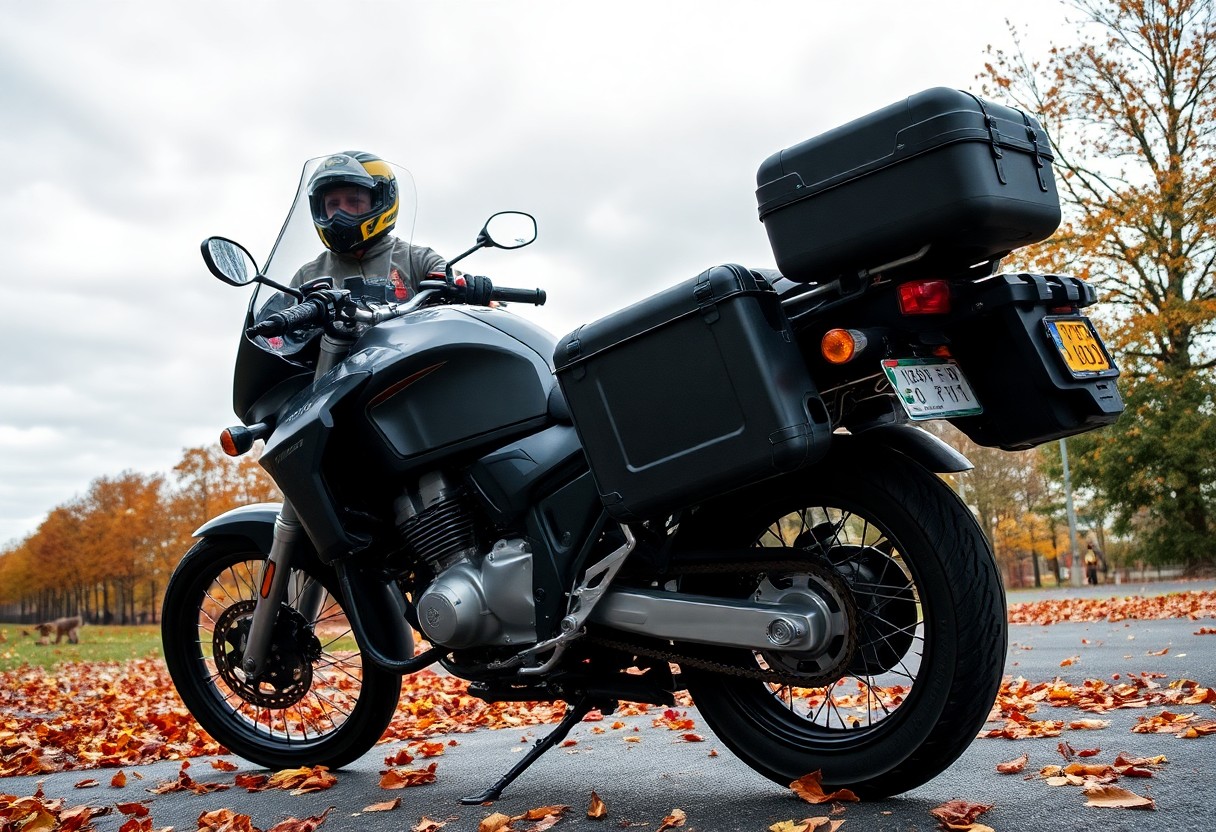Over the changing seasons, your motorcycle riding experience can vary widely with the weather. Whether it’s the heat of summer, the chill of winter, or the unpredictable spring and fall, adapting to these conditions is necessary for your safety on the road. This blog post will provide you with necessary tips to navigate different weather scenarios, ensuring that you can enjoy your ride while prioritizing your safety. By being informed and prepared, you can tackle any season with confidence and skill.
Understanding Weather Conditions
Your awareness of weather conditions is necessary for safe motorcycle riding. Different types of weather can dramatically affect visibility, traction, and your overall comfort while on the road. By understanding how to navigate various weather scenarios, you can better prepare yourself and mitigate risks associated with the elements, ensuring a safer ride no matter the season.
The Impact of Rain on Riding
The impact of rain on riding cannot be underestimated, as wet roads significantly reduce traction and increase stopping distances. Even a light rain can create slick conditions, particularly in the early stages when oils on the road surface mix with water. Keeping a steady speed, increasing following distance, and avoiding sudden maneuvers are necessary strategies to maintain control and safety during rainy rides.
Riding in Extreme Heat
Extreme heat can pose significant challenges for motorcycle riders, affecting both the bike and the rider’s performance. High temperatures can lead to overheating engines, decreased tire pressure, and increased fatigue for you. Staying hydrated, wearing appropriate gear, and taking regular breaks can help you manage the discomfort and hazards associated with heat while enjoying your ride.
To effectively combat the dangers of riding in extreme heat, prioritize your hydration by drinking plenty of fluids before and during your ride. Opt for lightweight, breathable gear to help regulate your body temperature, and plan your route to include frequent stops for rest in shaded areas. Keeping your motorcycle well-maintained, particularly the cooling system, is vital to prevent overheating. By taking these precautions, you can enhance your safety and enjoy your ride even in the hottest conditions.
Snow and Ice Riding Techniques
While riding in snowy and icy conditions, adjust your speed and increase your following distance to maintain control. Use smooth and gentle throttle inputs to avoid skidding, and try to steer with your body rather than your handlebars. Anticipate turns and braking points well in advance, and keep your tires in contact with the ground as much as possible. Practice using your brakes gently to gauge road traction, and always be aware of changing surface conditions.
Preparing Your Motorcycle for Winter
Behind every successful winter ride is a well-prepared motorcycle. Start by checking your tire tread and pressure, as proper grip is crucial on slippery roads. Make sure all fluid levels are topped up, including antifreeze, and give your battery a thorough check to prevent starting issues in the cold. Consider using winter-grade oil for better engine performance and inspect your brakes and lights to ensure maximum efficacy during these challenging conditions.
Safety Gear for Cold Weather
Above all, investing in quality safety gear for cold weather is paramount to enjoying your ride. Begin with a thermal layer underneath your riding suit, and opt for gloves with waterproof lining to keep your hands warm and dry. A full-face helmet with a visor is advisable to shield against harsh winds, while high-visibility jackets ensure you remain seen by others on the road in low-light conditions.
Considering the importance of comfort and protection during colder rides, your choice of safety gear can make all the difference. Look for insulated and waterproof gloves to protect your hands from the elements while maintaining dexterity for controls. Additionally, thermal base layers and heated vests or grips can provide much-needed warmth. Don’t forget a neck gaiter or balaclava to protect your face from bitter winds. Prioritize visibility and protection to boost your confidence as you navigate through winter’s challenges.
Fog and Low Visibility
Even in the most serene settings, fog can impair your visibility and pose serious risks while riding. When encountering fog, it’s necessary to reduce your speed, increase your following distance, and use both your low beam headlights and fog lights, if available. Keep in mind that other vehicles may have difficulty seeing you, so stay alert for unexpected obstacles and adjust your riding accordingly.
Riding Strategies for Fog
Behind the wheel, you need to adjust your focus and riding techniques in foggy conditions. Start by reducing your speed significantly, as lower speeds afford you more reaction time. Maintain a greater distance from vehicles in front of you and utilize your horn to alert others when necessary. Use your headlights to increase your visibility, keeping them on low beam to avoid blinding other drivers.
Importance of Reflective Gear
Importance of wearing reflective gear cannot be overstated, especially in low-visibility conditions. Bright colors and reflective materials significantly enhance your visibility to other road users, allowing you to be seen even when light conditions are poor.
At dawn, dusk, or in foggy environments, wearing reflective gear helps ensure that you stand out against dull backgrounds. This can make the difference between being noticed by other vehicles and going unseen. Investing in high-visibility jackets, helmets, and accessories not only boosts your safety but also conveys to other road users the importance of paying attention, thus fostering a safer riding environment for everyone.
Windy Conditions
Now, riding in windy conditions can be quite challenging for motorcyclists. Wind gusts can impact your stability and control, making it necessary to adjust your riding technique accordingly. Be aware of the direction and strength of the wind, especially when crossing open areas or bridges, where gusts might be stronger. Keeping these details in mind will help you maintain balance and safety while enjoying your ride.
Handling Strong Winds
Beside adjusting your speed and body position, it’s vital to stay focused on the road ahead when facing strong winds. Your bike’s response may change with sudden gusts, so keep both hands on the handlebars and be prepared to counteract any push from the wind. Leaning into the wind can help maintain your trajectory and control as you navigate through challenging conditions.
Best Practices for Stability
About ensuring stability while riding in windy conditions, you should adopt a slightly more aggressive riding posture. Lower your center of gravity by bending your elbows and knees, and keep your feet firm on the footpegs. This will provide better control over your motorcycle’s movements. Additionally, try to steer slightly into the wind when gusts hit, which allows you to counteract lateral movement. Staying relaxed and anticipating changes in wind can help enhance your overall riding experience.
It’s necessary to continually assess your surroundings while riding in windy conditions. Being proactive will allow you to react promptly to sudden shifts in wind strength and direction. Maintain a safe distance from other vehicles and be mindful of the potential for wind gusts to affect their stability as well. Adjusting your riding speed based on the wind’s intensity can further augment your stability and overall safety on the road.
Seasonal Maintenance Tips
To ensure optimal performance and safety throughout the riding seasons, seasonal maintenance is vital. Regular upkeep can prolong the life of your motorcycle and enhance your riding experience. Key maintenance tasks include:
- Checking tire tread and pressure
- Changing oil and filters
- Inspecting brakes and fluids
- Cleaning and lubricating the chain
- Testing lights and signals
Thou shall not overlook the importance of diligent maintenance.
Prepping Your Bike for Different Seasons
Across the riding calendar, different seasons bring unique challenges. In winter, you might need to use a battery tender and consider snow tire options. Summer may require you to check your cooling system and ensure proper airflow. You should adapt your bike to handle the conditions of each season for a safer ride.
Importance of Regular Inspections
About regular inspections, conducting thorough checks before hitting the road is vital for your safety. These inspections help you identify wear and tear or potential problems that may not be immediately apparent. By staying proactive, you can detect issues early on and avoid breakdowns or accidents during your rides.
To maintain your motorcycle’s safety and performance, prioritize regular inspections in your maintenance routine. Inspecting vital components like brakes, lights, tires, and fluids can save you from dangerous situations while riding. Staying proactive allows you to enjoy your rides with peace of mind that your bike is ready for any journey.
Defensive Riding Strategies
Many riders underestimate the importance of defensive riding strategies when facing adverse weather conditions. By staying aware of your surroundings and maintaining a safe distance from other vehicles, you can better react to unforeseen hazards. Always anticipate the unexpected, such as sudden rain or ice patches, and adjust your speed accordingly. Utilizing these strategies not only enhances your safety but also helps you navigate through difficult weather more confidently.
Anticipating Weather-Related Hazards
The ability to anticipate weather-related hazards is vital for safe motorcycle riding. Conditions such as rain, fog, and snow can significantly reduce traction and visibility, making it imperative for you to adjust your riding style. Always scan the road ahead for possible dangers, including puddles, oil slicks, or road debris, that might be exacerbated by changing weather. Being proactive in your approach ensures you can respond effectively to any challenges that arise.
Staying Alert in Changing Conditions
Any shift in weather can alter road conditions drastically, so it’s imperative that you stay alert while riding. Pay close attention to the weather forecast and be prepared for sudden changes that could affect visibility and traction. When conditions begin to deteriorate, reduce your speed and increase your following distance to allow more time for reaction. By maintaining your focus and being aware of environmental changes, you increase your chances of a safe ride.
Indeed, staying alert in changing conditions requires discipline and a keen sense of awareness. Your ability to notice subtle changes in the environment, such as shifting winds or dark clouds, can significantly affect your riding decisions. Make it a habit to adjust your focus regularly and scan the road for potential obstacles. This proactive observation will help you maintain control and navigate through unpredictable weather with greater confidence, enhancing your overall safety on the road.
Summing up
Summing up, understanding the impact of different weather conditions on motorcycle riding enhances your overall safety and enjoyment. By adapting your techniques to handle rain, snow, or extreme heat, you reduce the risks associated with various seasonal challenges. Always check weather reports, dress appropriately, and adjust your speed and braking distance to match road conditions. Your awareness and preparation are key to ensuring a safer ride, so equip yourself with the knowledge to navigate any season confidently.


